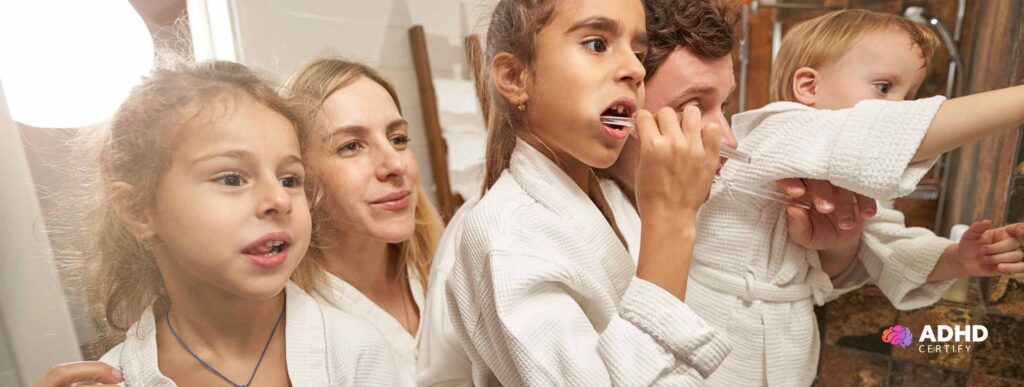Transitioning back to school after a break can be particularly challenging for children with ADHD.
Supporting ADHD children back to school requires a strategic approach that addresses both their academic and emotional needs.
According to NHS Digital, approximately 741,000 children and young people aged 5 to 24 in England are estimated to have ADHD, highlighting the widespread nature of this issue.
These challenges stem from disruptions in daily routines, heightened anxiety about new environments and expectations, and sensory sensitivities to school settings.
Parents and educators play a crucial role in supporting these children through structured routines, clear communication, and emotional support.
The move from home flexibility to school rigidity can be overwhelming for ADHD children. Let’s see why this happens and how we can support them through it.
Why ADHD Children Struggle with Back-to-School Transitions
The ADHD school transition can feel overwhelming, and it’s important to acknowledge the emotional and sensory challenges children face as they return to school.
Let’s explore some of the key reasons why this transition is so challenging.
Disruption of Routines
ADHD children thrive on routine, and sudden changes can lead to overwhelm. Disruptions in sleep schedules, meal times, and self-care routines can create additional stress, making it harder to adjust.
Anxiety and Uncertainty
Uncertainty about new teachers, classmates, and classroom rules can trigger anxiety.
ADHD children may also worry about falling behind academically or socially, increasing their stress levels. Transitioning back to school can feel like a huge adjustment for ADHD children. To make the process smoother, early preparation in August can significantly ease anxiety and help children adjust more gradually.
You can read more about how to set up the back-to-school routine in our article on preparing for the Back-to-School Transition: What to Do in August.
Sensory Sensitivity and School Environments
Classrooms, crowded hallways, and noisy environments can be overstimulating for ADHD children. These sensory challenges can lead to heightened anxiety and even meltdowns, making the school day even more difficult.
Practical Strategies for Easing the Transition
Creating predictable routines and offering emotional support can reduce anxiety and improve focus. Here are some practical ways to help ease the transition for ADHD children.
Establish a Back-to-School Routine Early
Start adjusting sleep times and daily schedules before school begins. Gradually practice school-like routines, such as waking up, getting dressed, having breakfast, and leaving the house at the same time each day.
Establishing a structured ADHD school routine before school begins can help minimise the shock of the transition.
Use Visual Schedules and Timers
Colour-coded charts, visual cues, and timers are excellent tools to help children with ADHD anticipate transitions and manage their time better. These visual aids help make the day more predictable and reduce uncertainty.
Break Tasks into Manageable Steps
To help ADHD children focus, break tasks into smaller, manageable steps. For example, encourage them to focus on one thing at a time, like putting on their shoes before heading out the door. You can also use checklists for tasks such as packing school bags or getting dressed to keep them on track.
Managing ADHD school anxiety starts with creating a predictable and calming environment before school begins, reducing the stress that comes with new routines.
Supporting Emotional Readiness
Emotional preparation is just as important as academic readiness for ADHD children. Here are some strategies to support their emotional well-being during this transition.
Talk About the Changes in Advance
Discuss the upcoming school year, new teachers, and any potential worries your child may have. Using social stories or role-playing can help children visualise school scenarios and feel more prepared for the changes.
Encourage Self-Regulation Tools
Helping children with ADHD emotional regulation techniques such as deep breathing or taking breaks can provide relief during stressful moments at school.
Teach your child calming techniques such as deep breathing or taking short breaks when feeling overwhelmed. These self-regulation tools can help them manage their emotions and cope with anxiety.
Be Patient and Compassionate
Understand that adjusting to a new routine can take time for ADHD children. Offer reassurance, patience, and empathy when they struggle with changes. Let them know that it’s okay to take things one step at a time.
How to Prepare Academically for the School Year
ADHD school readiness isn’t just about academics, but also preparing emotionally and socially for the new school year.
ADHD children may need extra support to get organised and stay on track with schoolwork. Here are some steps to help prepare them for the academic year ahead.
Organise School Supplies and Materials Early
Prepare school supplies ahead of time, ensuring everything your child will need is ready for the first week. From pencils to notebooks, laying everything out in advance helps reduce stress. Use labels and colour-coding to make it easier for them to identify their belongings quickly.
Communicate with the School
Meeting with teachers or SENCOs before the school year starts is essential. Discuss any special accommodations your child may need and ensure the school understands their ADHD challenges and emotional needs.
Practice Focused Learning Tasks Before School Starts
Start practising small, timed tasks to help your child get used to the structure of schoolwork. Incorporating ADHD coping strategies like using a fidget tool while working or taking scheduled breaks can improve focus and reduce frustration.
In addition to emotional support, ensuring ADHD school readiness through early academic preparation can set your child up for success.
When to Seek Additional Support
There are times when the challenges of transitioning back to school may be too much for your child to handle alone. Professional support can make a significant difference and provide the guidance needed for a smoother adjustment.
When Anxiety or Resistance Is High
If your child consistently refuses to go to school or shows signs of severe distress, it’s time to seek professional advice. It may also be worth considering an ADHD assessment if you suspect new or undiagnosed issues.
If Meltdowns Become Frequent
Frequent meltdowns and emotional dysregulation may indicate the need for a tailored intervention plan.
Find more information on ADHD assessments and how to get started with Child ADHD assessment services in the UK.
Reach Out to a Child Psychologist or ADHD Specialist
Consulting a child psychologist or ADHD specialist can help your child develop effective coping strategies and address any underlying emotional or behavioural challenges.
Final Thoughts
Every child with ADHD is unique, and the process of transitioning back to school will look different for each one. It’s important to remember that adjustments take time, and there’s no one-size-fits-all approach. Some children may adapt quickly, while others might need more time and support to feel comfortable in their new routine.
Transitioning back to school with ADHD is a process, and it’s okay if your child needs time to adjust. The key is to provide consistent support, patience, and understanding. Encouragement, small wins, and offering a safe space for them to express their feelings can go a long way in reducing anxiety and boosting confidence.
If you’re finding the transition challenging or if your child continues to struggle, seeking professional help can make a huge difference. Emotional and academic support are both vital for your child’s well-being, and early intervention can pave the way for long-term success.
Start your ADHD assessment or find support resources for ADHD children at ADHD Certify.
Frequently Asked Questions
How can I help my child with ADHD adjust to school routines?
Start by establishing a consistent routine at home before school begins. Use visual schedules and timers to help them anticipate transitions and practise getting ready for school at set times.
What are the common symptoms of ADHD in children that affect school performance?
Common symptoms include difficulty staying focused, impulsivity, poor organisation, and challenges with time management. They may also struggle with following instructions and sitting still during lessons.
Should I tell my child’s teacher about their ADHD before school starts?
Yes, informing the teacher ahead of time allows them to prepare strategies and accommodations that will support your child’s learning and emotional needs.
How can I manage my child’s school-related anxiety with ADHD?
Create a predictable routine, talk about potential worries in advance, and teach calming techniques like deep breathing. Offer reassurance and focus on positive aspects of school.
What should I do if my child is constantly frustrated by schoolwork?
Break tasks into smaller steps, use positive reinforcement, and work with the teacher for additional support. If frustration persists, consider seeking advice from an ADHD specialist.




